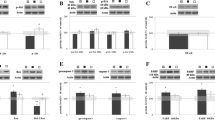Summary
Anin vivo model of glutamate excitotoxicity in which glutamate is applied to the cortex of rats through a microdialysis probe has been used to investigate the neuroprotective processes initiated by 17ß-estradiol. Rats were pre-treated with 17ß-estradiol i. v. before local application of glutamate. The experimental results showed that pre-treatment with 17ß-estradiol significantly reduced the size of the glutamate-induced lesion. In the microdialysates, the peak of lactate observed immediately after glutamate application was significantly higher and longer lasting after 17ß-estradiol pre-treatment. The level of extracellular glucose was markedly decreased concomitantly to the increase in lactate, but no difference could be observed with and without 17ß-estradiol pre-treatment. These suggest a new neuroprotective mechanism of 17ß-estradiol by activating glutamate-induced lactate production. This effect on lactate production and lesion reduction is estrogen receptor dependent and is abolished totally by estrogen antagonist tamoxifen. It was also demonstrated here that high lactate subserves estrogen neuroprotection during glutamate toxicity.
Similar content being viewed by others
References
McHugh N A, Merrill G F, Powell S R. Estrogen diminishes postischemic hydroxyl radical production. Am J Physiol, 1998, 274: H1950
Singer C A, Rogers K L, Strckland T Met al. Estrogen protects primary cortical neurons from glutamate toxicity. Neurosci Lett, 1996, 212: 13
Dubal D B, Kashon M L, Pettigrew L C. Estrodiol protects against ischemic injury. J Cereb Blood Flow Metab, 1998, 18: 1253
Culmsee C. Neroprotetion by estrogens in a mouse model of focal cerebral ischemic and in cultured neurons: evidence for a receptor-independent antioxidative mechanism. J Cereb Bliid Flow Metab, 1999, 19: 1263
Obrenovitch T P, Urinjak J. Altered glutamaterigic transmission in neurological disorders: from high extracellular glutamate to excessive synaptic efficacay. Prog Neurobiol, 1997, 51: 39
Meldrum B S. Excitatory amino acid receptors and their role in epilepsy and cerebral ischemia. Ann N Y Acad Sci, 1995, 757: 492
Alessadri B. Glucose and lactate metabolism after severe human head injury: influence of excitatory neurotransmitters and injury type. Acta Neurochir Suppl, 1999, 75: 21
Pellerin L, Magistretti P J. Glutamate uptake stimulates Na+, K+ ATPase activity in astrocytes via activation of a distinct subunit highly sensitive to ouabain. J Neurochem, 1997, 69: 2132
Tong C K, Chesler M. Endogenous pH shifts facilitate spreading depression by effect on NMDA receptors. J Neurophysiol, 1999, 81: 1988
Choi D W. Acute brain injury, NMDA receptors, and hydrogen ions: observation in cortical cell cultures. Adv Exp Med Biol, 1988, 268: 501
Mor G. Estrogen and microglia: A regulatory system that affects the brain. J Neurobiol, 1999, 40: 484
Chaudhry F A. Glutamate transporters in glial plasma membranes: highly differentiated localizations revealed quantitative ultrastructural immunocytochemistry. Neuron, 1995, 15: 711
Author information
Authors and Affiliations
Additional information
This project was supported by grants from the Novartis Foundation and the department of Surgery, University Hospital Basel, Switzerland.
Rights and permissions
About this article
Cite this article
Jincao, C., Ting, L., Ritz, M.F. et al. Effect of 17β-estradiol on the brain damage and metabolic changes in rats. Current Medical Science 21, 62–64 (2001). https://doi.org/10.1007/BF02888040
Received:
Published:
Issue Date:
DOI: https://doi.org/10.1007/BF02888040




